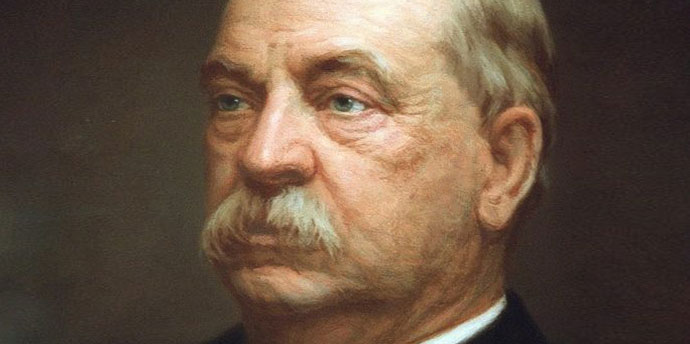Above: Grover Cleveland was among the presidents underrated by the survey.
This essay was first published in the February 27, 2024 Epoch Times.
The latest ranking of U.S. Presidents—the American Political Science Association’s Presidential Greatness Survey—has been mocked for such absurdities as rating President Joe Biden over Ronald Reagan and placing Donald Trump as dead last.
However, the establishment media treats rankings like this as serious news. So it is worthwhile to examine the Presidential Greatness results in more detail.
As I pointed out in a previous essay, surveys of this kind commonly suffer from two basic flaws: One flaw is the questions. The other is the answers.
The problem with the questions is that most are irrelevant to the president’s job description. That job description is set forth in the Constitution, primarily (although not exclusively) in Article II. Among other duties, the Constitution assigns the President the job of enforcing the laws, carrying out foreign policy, and commissioning (and therefore instructing) executive officers.
Moreover, the Constitution deliberately creates institutional tension between the President and Congress, encouraging them to check each other and compete against each other for popular approval.
Yet instead of focusing on the job description, the surveys often pose questions about a president’s “vision” and his effect on American society. They also frequently award points for cooperating with, rather than checking, Congress.
The answers to these surveys seem driven more by partisan bias than by dispassionate historical analysis. Most of the respondents are academics, who as a group are overwhelmingly left of center. Moreover, they reside in university “bubbles” from which conservative views are largely excluded. The Presidential Greatness project in particular surveyed “current and recent members of the Presidents & Executive Politics Section of the American Political Science Association.” That organization leans strongly left, as evidenced by its deep commitment to the “diversity, equity, and inclusion” agenda.
The Modern Republican-Democrat Divide
One way to capture the partisan nature of the Presidential Greatness rankings is to examine the survey’s treatment of presidents who have served in office since 1909. Theodore Roosevelt, the last (and only) avowed “big government” Republican, left office that year. That began the modern perceived division between Democrats as “liberal” advocates of bigger government and Republicans as “conservative” advocates of free enterprise and smaller government.
Prior to TR’s administration, politicians of both parties were more mindful of the Constitution’s limits on federal power. Policy differences centered on such issues as pro-British vs. pro-French foreign policies, territorial expansion, slavery, protective tariffs, and monetary policy.
Admittedly, the perceived division since 1909 is not always grounded in reality. Several GOP Presidents have expanded federal power considerably. Herbert Hoover sponsored huge increases in federal spending. Richard Nixon increased the regulatory state and the federal role in criminal law. Dwight Eisenhower, George H.W. Bush, and George W. Bush all augmented the federal role in K-12 education.
And on the Democrat side of the partisan divide, Jimmy Carter began the process of government deregulation that continued under Reagan.
Still, Republican Presidents are widely viewed as more conservative than their Democratic counterparts, and this certainly is true among academics. So we can expect academics to be more sympathetic to Democratic presidents than to Republican presidents.
What the Numbers Show
The numbers confirm the partisan bias of the Presidential Greatness survey.
Twenty Presidents—nine Democrats and 11 Republicans—have served in office since 1909. Since there is no evidence that Democratic politicians are inherently more or less capable than Republican politicians, we would expect both political parties to have their share of good and bad presidents.
But those responding to the Presidential Greatness survey seem to think almost all Democrats are better than almost all Republicans. Specifically:
- In the survey, every Democratic president elected since 1909 was ranked among the top half of all presidents. Among the 11 Republicans, only three were in the top half.
- The highest post-1909 Democrat was Franklin D. Roosevelt (2nd), the architect of the modern welfare state. The lowest was Carter (22nd), the only Democrat to reduce the government’s role in some areas of the economy.
- Dwight Eisenhower (8th), the highest Republican, presided over an inconclusive administration whose “accomplishments” included expanding the federal role in education, allowing an Egyptian dictator to seize the Suez Canal, standing by while Soviet tanks rolled into Hungary, and fighting the conservative wing of his own party. The lowest Republican president, Donald Trump (45th) was, like Carter, responsible for significant deregulation.
- Somehow, every post-World War II Democrat except Carter managed to make the list of the top 12 presidents of all time: Franklin Roosevelt (#2), Harry Truman (#6), Barack Obama (#7) Lyndon Johnson (#9), John F. Kennedy (#10), and Bill Clinton (#12). Aside from Roosevelt’s victory in World War II, and the ultimately-baleful legislative successes of Johnson, it is difficult to identify any lasting and positive achievements among this group. Certainly none accomplished feats comparable to the foreign policy successes of Reagan (16th), George H.W. Bush (19th), John Adams (13th), James Monroe (#18), or James Polk (25th).
- The average rank of the nine post-1909 Democrats is 10.8, out of 45. The average rank of the eleven Republicans is far lower: 28.6.
Two other rankings complete the partisan picture: (1) that of the last pre-1909 Republican, Theodore Roosevelt, and (2) that of the incumbent, Joe Biden. Both of their administrations were notable for their disregard of constitutional limits and for exercises in power that many argue have a nearly fascist quality.
The fact that the academics answering the Presidential Greatness survey ranked TR 4th and Biden 14th tells us more about the sickness in the universities than about our presidents.








